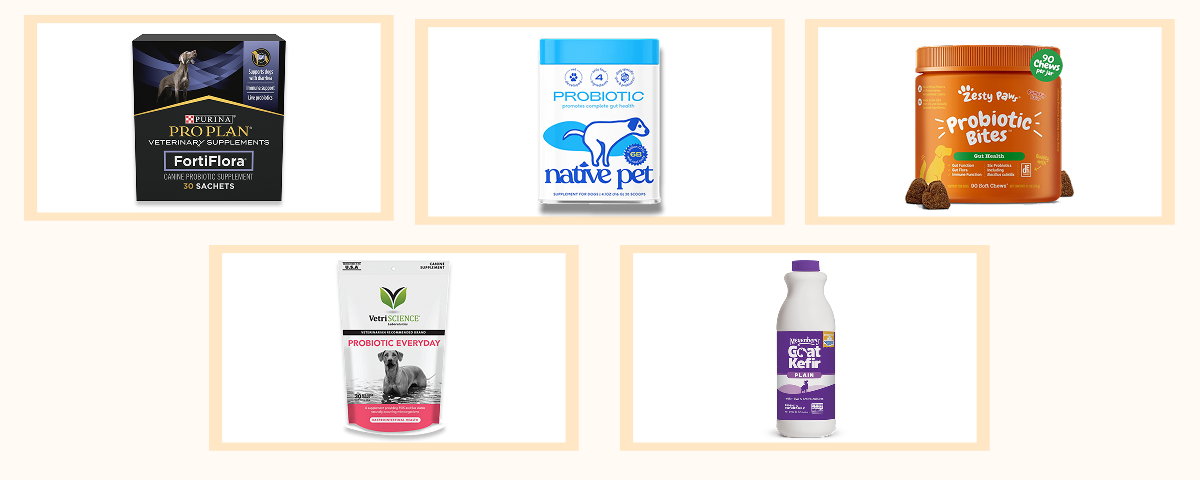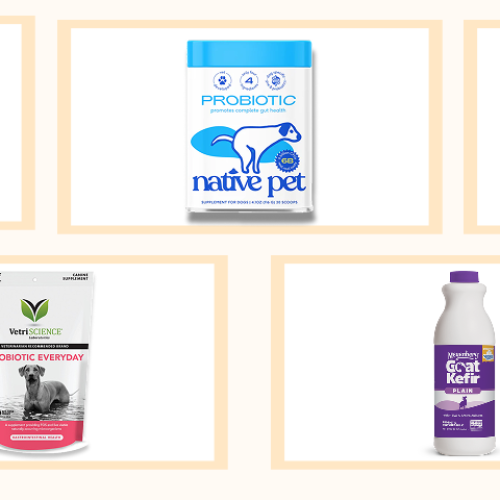Why I Turned to Probiotics in the First Place
If you share life with a Golden Retriever, you probably know the soundtrack of constant jingle-jangle tags, thumping tails…and scratching. Last fall my sweet boy Jasper began chewing his paws raw and shimmying on the carpet like a furry mop. Our veterinarian ruled out fleas and prescribed a short course of antihistamines, but the relief was fleeting. When I learned that a healthy gut may calm systemic inflammation—and, by extension, itchy skin—I added “probiotic experiment” to my to-do list.
Before I dive in: I’m a dedicated dog mum, not a vet. Always chat with your professional before changing your dog’s regimen.
How I Chose the Test Line-Up
I wanted products that met at least three criteria:
- Canine-specific strains (human capsules weren’t my first choice).
- Clear CFU count—preferably 1 billion+ per serving.
- Third-party testing or veterinary backing.
After a little label detective work (and a lot of reading ingredient lists in the pet-store aisle while Jasper licked random strangers), I landed on four commercial probiotics and one DIY option. We tested each for 30 days, with a 10-day “reset” between products.
The Contenders at a Glance
| Product | Form | Daily Cost | Jasmin’s Convenience Score (1–5) | Jasper’s Scratch-Relief Score (1–5) |
|---|---|---|---|---|
| Purina Pro Plan FortiFlora | Flavored powder | $0.96 | 5 | 4 |
| Zesty Paws Probiotic Bites | Soft chew | $0.78 | 4 | 3 |
| VetriScience Probiotic Everyday | Duck-flavored chew | $0.55 | 4 | 2 |
| Native Pet Probiotic Powder | Unflavored powder | $0.84 | 3 | 5 |
| Plain Goat’s Milk Kefir (DIY) | Liquid | $0.40 | 2 | 1 |
(Scores are purely personal; your mileage—and your dog’s microbiome—may vary.)
What Worked
1. Native Pet Probiotic Powder—Our Surprise Champion
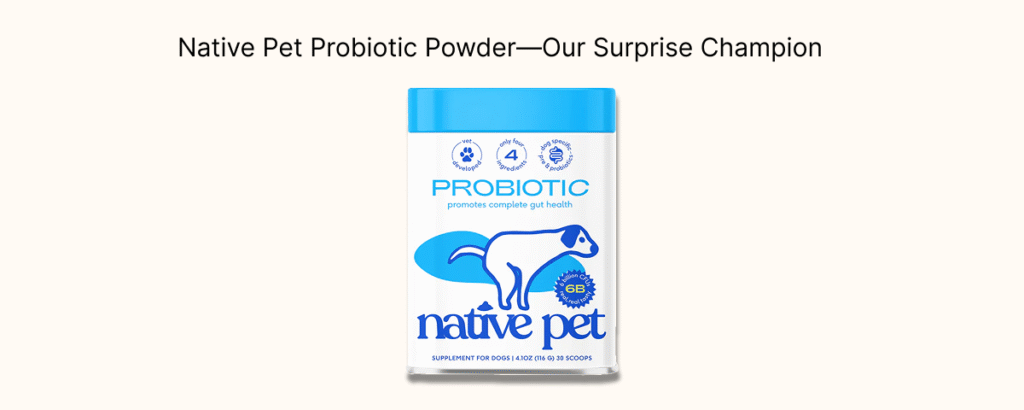
After two weeks Jasper’s paw-licking dropped from constant to occasional, and the angry pink rash on his belly faded to a pale peach. This powder blends Bacillus coagulans and Bacillus subtilis with organic pumpkin. The neutral flavor disappeared in kibble; I did, however, need to whisk it into a little water first to avoid “dust-bunny” clumps. Worth it for the calm skin and gentler gas schedule in the evenings.
Pros
- High CFU count (6 billion).
- No poultry flavoring—helpful if your dog reacts to chicken.
- Resealable metal can, not a flimsy pouch.
Cons
- Scoop buries itself; prepare to dig like a pirate.
- Pricier than chews, especially for a 70-lb Golden.
2. Purina Pro Plan FortiFlora—Solid Runner-Up
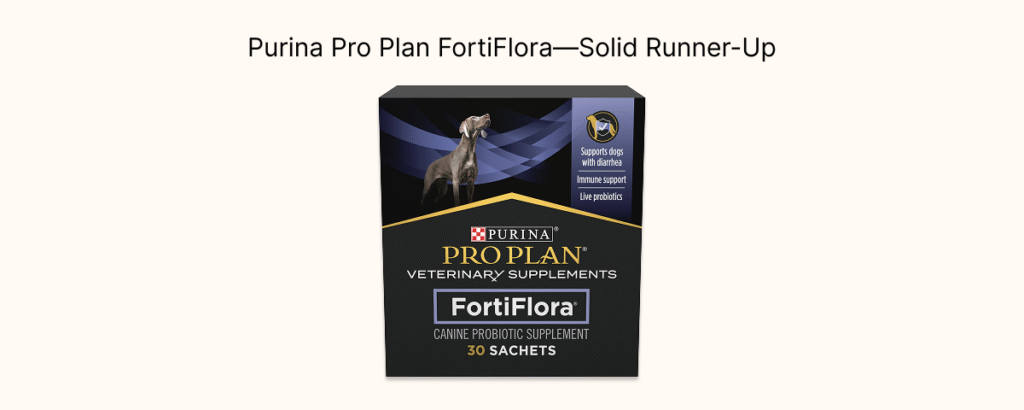
FortiFlora is practically the Kleenex of canine probiotics, and its cult status is deserved. Jasper’s scratching improved noticeably by day 10, though not as spectacularly as with Native Pet. The packet format makes dosing foolproof, which is a blessing on bleary-eyed mornings.
Pros
- Backed by published veterinary research.
- Liver flavor turned Jasper’s bland prescription food into a party.
- Single-serve sachets eliminate guesswork.
Cons
- Contains animal digest, so sensitive tummies may rebel.
- Paper packets = more waste in the trash bin.
The Middle Ground
Zesty Paws Probiotic Bites
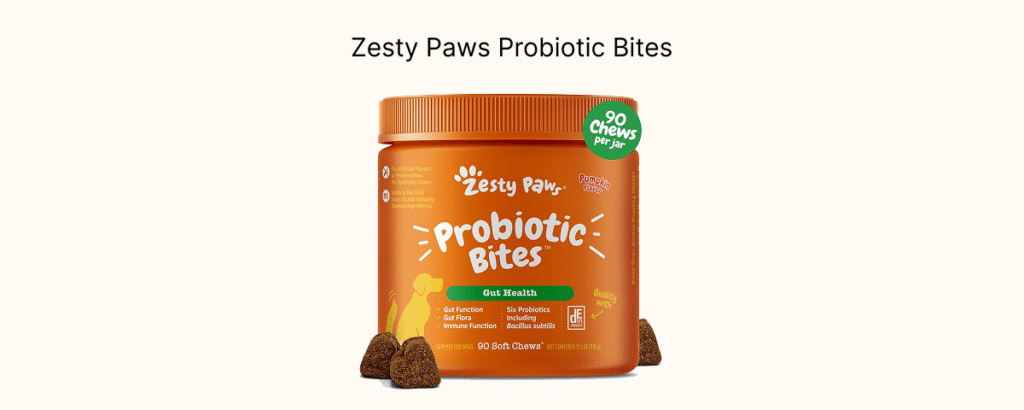
These chewy little hearts were my favorite to administer—open jar, toss treat, receive drool. Jasper’s coat grew glossier, but the paw-chewing only eased slightly. My guess? The daily dose tops out at 3 billion CFUs, perhaps too modest for a large dog with full-blown itch fits.
VetriScience Probiotic Everyday
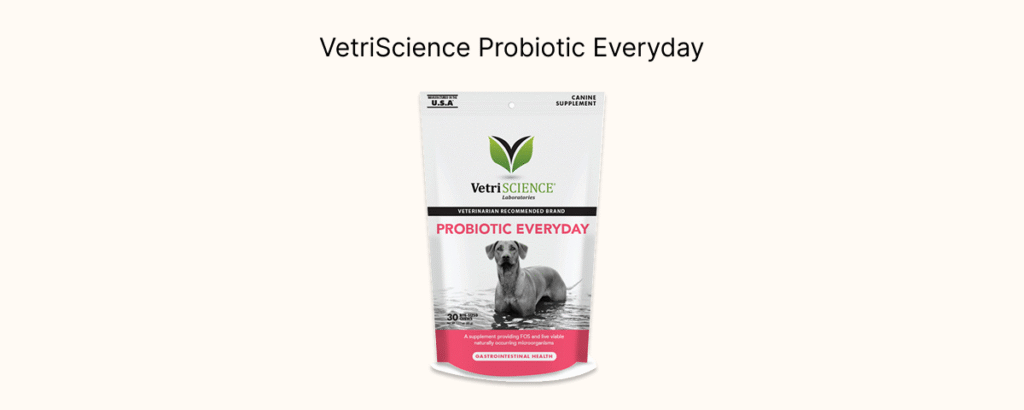
Our vet stocks this brand, and I loved the duck flavor option (chicken is omnipresent in dog products). Sadly, Jasper’s scratching plateaued. On the bright side, his digestion stayed rock-steady; no midnight trips outside.
What Flopped
Plain Goat’s Milk Kefir
Friends in my agility group rave about kefir’s probiotic punch, so I tried ¼ cup poured over dinner. Jasper adored the tangy topping, but after three weeks his belly rash actually darkened. A quick food-sensitivity test later, we learned he reacts to casein proteins. Lesson learned: fermented dairy is still dairy.
Four Lessons the Journey Taught Me
- Strain specificity matters. Products listing generic “Lactobacillus” without the strain code are basically mystery boxes.
- Count isn’t everything; survivability is. Spore-forming Bacillus strains handled Jasper’s stomach acid better than fragile lactobacilli.
- Watch the extras. Some chews hide chicken meal or high fructose syrups that cancel out gut-health benefits.
- Give it time—but not forever. I saw the first improvements between days 10-14. If nothing changes by week 4, pivot.
Frequently Asked Questions from Fellow Golden Parents
Q: Can I pair probiotics with antihistamines?
A: Yes—our vet confirmed there’s no interaction. Jasper spent the first ten days on both, then tapered off meds when the probiotic kicked in.
Q: Are human probiotics safe?
A: Some are, but dosages skew small and many strains haven’t been studied in dogs. If you experiment, choose an unflavored capsule with at least 5 billion CFUs and start slowly.
Q: Should I refrigerate powdered supplements?
A: Check the label. Shelf-stable spores live happily in the pantry; dairy-based cultures need the fridge.
My Current Routine
Jasper now gets 1 ½ scoops of Native Pet powder with breakfast and a fish-oil capsule at dinner. His scratching is down 80%, and his golden coat looks like it belongs in a shampoo commercial. I still keep FortiFlora sachets on hand for travel days when kibble changes or stress might trigger tummy trouble.
Final Thoughts
Probiotics aren’t a one-size-fits-all magic sprinkle, but they shifted the odds in Jasper’s favor. The key is patience, record-keeping, and a willingness to pivot when your dog’s body calls foul. If itchy skin is turning your household into a scratch symphony, consider recruiting a targeted probiotic—your pup’s paws (and your carpet) may thank you.
Here’s to happier guts, calmer skin, and many carefree walks ahead!

